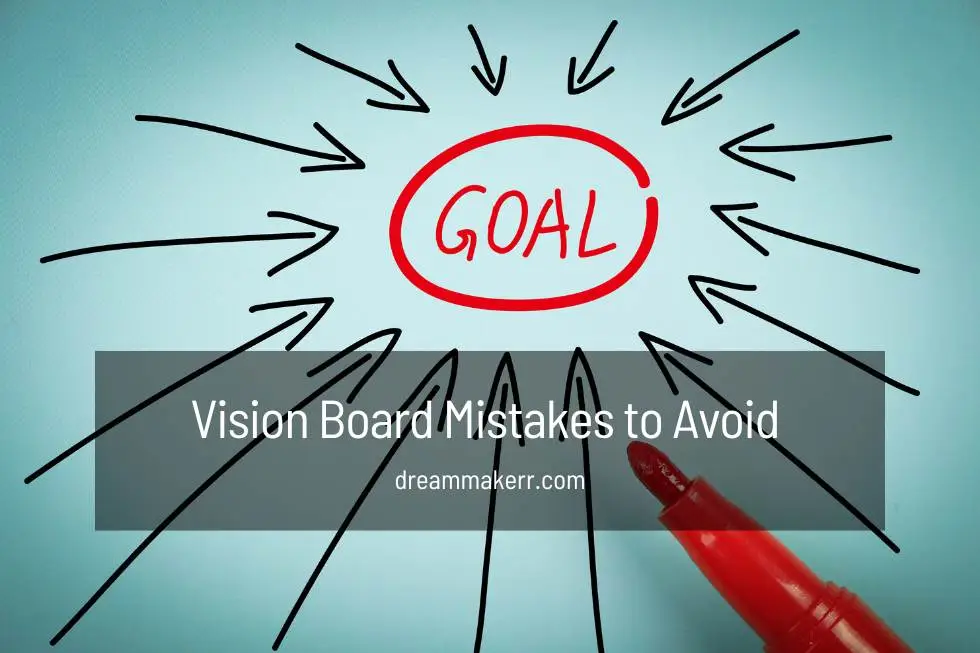On this page

Vision Board Mistakes: 6 Common Errors to Avoid With Your Board
Few tools are as effective as a well-crafted vision board when achieving our goals.
However, not all boards are created equal – some end up falling short because of common vision board mistakes people make along the way.
- The first mistake is failing to be specific about what we want to achieve. Without clarity around our goals, we will unlikely stay motivated over time.
- Another issue is creating busy, chaotic boards that don’t convey a strong sense of purpose or emotion – instead of feeling energized by our visions; we feel scattered and unfocused.
- Ultimately though, the most significant error people make with vision boards has nothing to do with their design or content – it’s simply neglecting to take action toward their daily goals!
A vision board that lacks these qualities is ineffective.
There are plenty of people out there who swear by the power of vision boards to manifest their dreams into reality. But here’s what they often overlook: while visual aids can help clarify your goals and motivate you towards them, true success comes down to taking concrete actions.
In other words simply looking at your vision board won’t get you anywhere. It takes consistent effort and dedication to make those plans materialise into tangible outcomes.
As one expert advises: “Your vision board might help you dream big; but it’s the action that turns those dreams into reality.”
1. Not Clarifying Your Vision
Are you eager to create a powerful vision board that reflects all of your dreams and goals? A common mistake many people make is rushing into the process without really clarifying their overall vision first.
To avoid this misstep take some time beforehand to really think about what matters most in life:
- What do you hope to accomplish in the long run?
- Are there any specific values or beliefs that drive you forward?
- What do you want your perfect day to look like?
These questions will help you craft a vision that aligns with your true self.
Remember to be specific when defining your goals as well.
Vague statements like “I want to be successful” can lead to confusion and lack of focus on the board itself. Instead think about what success means for you personally – whether it’s hitting a financial milestone or pursuing a passion project.
When we have a clear understanding of our desired outcomes in life we’re better equipped to create actionable plans and work towards realising our dreams.
By focusing on our vision and taking deliberate steps towards our vision, we can turn even the loftiest goals into achievable milestones.
However, we should aim for spiritual goals, not only materialistic goals.
2. Focusing Too Much on Material Things
When planning out your goals on your vision board, it is common for people to hyper focus on materialistic goals, such as cars or jewellery.
After all, who doesn’t want nice things?
But don’t let yourself get carried away by this kind of thinking!
You need more than just “physical things” in order to find true happiness.
Taking time for personal growth initiatives. Nurturing meaningful relationships can bring immense satisfaction too; not just owning more “bling”.
Lets also consider health & wellness along with spiritual development as important areas to focus on.
These could include:
- Personal growth
- Relationships
- Health
- Spirituality
Variety is key when it comes to creating a vision board that really resonates.
3. Not Being Specific Enough
When talking about creating a perfect vision board most people overlook the importance of specificity.
For example, you could end up asking for more money on your vision board, which may not be specific enough.
Your goal must be specific:
- Do you want to start a side gig to earn an extra $1k/month?
- Are you looking to get a better paid job?
- Do you want to earn $500.000/year after taxes from your startup business?
Without specific goals in mind, your vision board may not be as effective as it could be.
It would help if you had precise goals and objectives laid out with proper details to increase its effectiveness.
A clear picture helps better than vagueness!
- Breaking down large dreams into smaller steps allows for easier visualization – making your aims much easier to achieve in reality.
- Instead of just including a picture add detailed descriptions that define what exactly it is that motivates you!
- Making an effective vision board requires more than just slapping random images together.
- It necessitates careful planning and clear communication about what you want out of life.
To achieve this, break down your aspirations into practical tasks so that they are easier for you to work towards every day.
When done correctly this process will help create a powerful visual tool that inspires action towards achieving those dreams and goals!
4. Using Other People’s Visions
When crafting your inspirational vision board you may be tempted to use someone else’s goal instead of your own.
However doing so may lead you down a path lacking motivation or connection with your desired outcome.
Identifying what matters most to you before creating your vision board is essential in ensuring alignment between your values and goals.
When you take time for self reflection and determine personal goals based on what matters most in life it becomes easier to establish an actionable plan towards achieving them successfully.
Moreover, while seeking inspiration from others’ successes may offer valuable insights into strategy or approach towards achieving goals comparisons can quickly become toxic if they result in feelings of inadequacy or self doubt.
Each person has their unique journey; thus developing an individualized plan reflective of personal beliefs is crucial towards successful manifestation.
If you’re feeling stuck in achieving your life aspirations, take some time for reflection.
Start by contemplating what is important in life and what truly motivates you.
From there create a vision board aligned with these values – it will help keep your commitment strong during the journey towards realising those goals!
Related: 80+ Vision board ideas to get you inspired
5. Not Updating Your Vision Board Regularly
Your vision board is a representation of all the wonderful things you hope to achieve in life. If it’s not updated regularly those aspirations may become obsolete. Or even worse, irrelevant over time.
That’s why taking the time to revisit and revise your vision board periodically is so important.
This practice allows you space for reflection while keeping sight of what matters most.
One way to keep track of changes in priorities is by scheduling updates every month:
- add new images or words based on what matters most right now
- remove anything that doesn’t resonate anymore
- rearrange everything for maximum impact!
By staying mindful about any shifts in focus toward achieving key milestones (no matter how big or small). This way, we can make sure our motivation stays strong. Toward realizing our dreams.
The beauty of a vision board lies in its ability to evolve alongside us.
When we reach a certain goal on our board it’s important to refresh the space with new aspirations that speak to our present desires.
The result is an ever evolving and inspiring tool for motivation and manifestation.
6. Not Taking Action
Not taking action is one of those classic vision board mistakes. There’s no way around it. One must do something in order to get something.
Think about it, did you ever get anything for free?
Probably not.
When creating a vision board many people fall into the trap of thinking that simply envisioning their goals will make them happen.
But this couldn’t be further from the truth.
Without action, even the most well placed visions will remain unrealized.
A vision board is only one tool in achieving your ambitions; it takes concerted effort to turn these ambitions into reality.
One technique that can help is breaking down larger aims into smaller tasks;
for example, if you want to run a marathon but are new to running, focus first on shorter distances like 5ks or 10ks before setting your sights on longer runs.
But what about accountability?
One way is finding an accountability buddy who will check in with us regularly and encourage us on our journey towards our desired outcomes.
Making progress towards your goals is easier when you involve other people by sharing your vision board or setting clear deadlines.
It’s important to remember that the vision board alone won’t get you there alone – taking action is essential.
Conclusion
Achieving success through visualization often requires more than just creating a traditional vision board; avoiding common vision board mistakes is equally as essential when setting out on this journey.
Mistakes such as failing always meant being too high level with one’s desires or lacking clarity on specific outcomes may create room for confusion or depression.
This also occurs when people fail to take necessary action towards realising set goals making the vision board premise and its potential ineffective.
In addition cluttered visual representations can make tracking progress difficult or even entirely derail concentration on priorities.
To avoid these challenges one should ensure that their vision board is organized appropriately and has a clear hierarchy of self set priorities.
Emotional attachment to one’s goals and dreams are an important aspect of success when leveraging the potential of a vision board.
With such an attachment comes a compelling sense of purpose that fuels tenacity in the pursuit of objectives and this makes what may have initially seemed impossible to achieve become achievable with time.
When mapping out your vision for the future on a physical board remember that every image or word should have meaning beyond just its aesthetic appeal.
It’s important that each element resonates with something deep inside of yourself – be it a long held value, dream or passion – so that when things get tough on the path towards success, these emotions can fuel your drive forward.

Petri Maatta is a mindset coach and neuroscience-focused author with 15 years of experience in personal transformation and success psychology. After seven years of business failures, he discovered the power of manifestation through a Fortune 500 mentor. Now, he shares neuroscience-backed strategies through DreamMaker membership, helping others transform their businesses and lives on their own terms.
Read My Story here.
Share This Story, Choose Your Platform!
You want to manifest a new car, but you’re wondering: Does this really work? Here’s
Many smart individuals are often linked with having a high IQ. However, according to emotional
According to online dating statistics over 90% of people believe in love at first sight,




